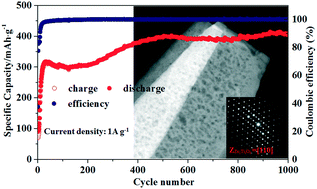In situ topotactic synthesis of a porous network Zn2Ti3O8 platelike nanoarchitecture and its long-term cycle performance for a LIB anode†
Abstract
This paper introduces the in situ topotactic synthesis of a porous network Zn2Ti3O8 platelike nanoarchitecture via using layered H1.07Ti1.73O4·H2O (HTO) as the precursor. The introduction of H2O2 in the interlayer of HTO leads to access of more Zn2+ ions into the interlayers and the formation of the Zn2+ ion-exchanged product with a Zn/Ti molar ratio of 1.07 : 1.73 during ion exchange. This ion-exchanged product is in situ topotactically transformed into a Zn2Ti3O8 nanoarchitecture after heat-treatment, and the [110]-crystal-axis of the Zn2Ti3O8 nanoarchitecture is vertical to the basal plane of the 2D nanoarchitecture. The H2O2 molecule within the ion-exchanged product decomposes and escapes due to heat-treatment, resulting in the formation of a porous network structure similar to a sponge. The pore size is about 10–20 nm. Moreover, the electrochemical investigation indicates that such a porous network Zn2Ti3O8 nanoarchitecture as a Li-ion battery anode has a reversible capacity of 423 mA h g−1 during the 100th cycle at a current density of 100 mA g−1. It is wondrous that at a current density of 1 Ag−1 during 1000 cycles, its reversible capacity still remains at 408 mA h g−1.



 Please wait while we load your content...
Please wait while we load your content...